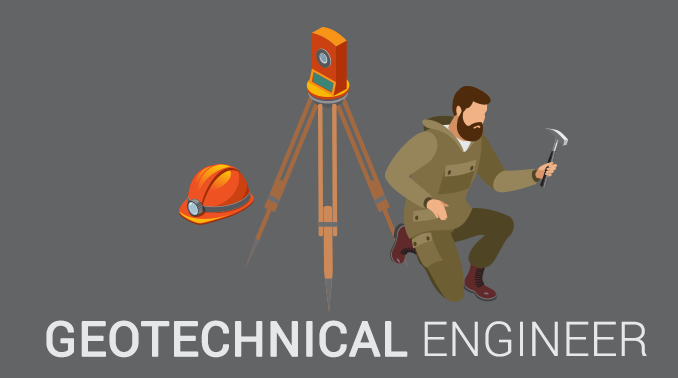An Unbiased View of Consulting Engineers
An Unbiased View of Consulting Engineers
Blog Article
Getting The Consulting Engineers To Work
Table of ContentsThe 15-Second Trick For Consulting EngineersConsulting Engineers for BeginnersNot known Incorrect Statements About Consulting Engineers Some Known Details About Consulting Engineers Indicators on Consulting Engineers You Need To KnowThe Ultimate Guide To Consulting Engineers
To supply the best experiences, we make use of innovations like cookies to shop and/or gain access to device information. Consenting to these innovations will certainly enable us to process data such as surfing habits or special IDs on this site.They conduct website investigations, gather examples, execute laboratory tests, and assess information to evaluate the suitability of the ground for building tasks. Based upon their searchings for, geotechnical engineers offer suggestions for foundation style, slope stability, maintaining frameworks, and reduction of geotechnical threats. Consulting Engineers. They team up with various other professionals, such as architects, structural engineers, and building and construction teams, to guarantee that geotechnical considerations are integrated into the overall project design and implementation
The Ultimate Guide To Consulting Engineers
They interpret the data to recognize the properties and behavior of the soil and rock, including their strength, leaks in the structure, compaction qualities, and groundwater conditions. Geotechnical Evaluation and Style: Geotechnical engineers analyze the information accumulated during website examinations to examine the stability and viability of the website for building tasks. They perform geotechnical computations and modeling to examine elements such as birthing capability, negotiation, incline stability, side earth pressures, and groundwater circulation.
Structure Design: Geotechnical designers play a vital role in making foundations that can securely support the designated structure. They examine the soil conditions and lots requirements to determine the suitable structure type, such as superficial structures (e.g., footings), deep structures (e.g., heaps), or specialized methods like dirt improvement. They think about factors such as settlement restrictions, bearing capability, and soil-structure communication to develop ideal foundation designs.
Below are some types of geotechnical engineers: Foundation Designer: Structure engineers focus on making and analyzing foundations for frameworks. They analyze the soil conditions, tons needs, and website characteristics to figure out one of the most appropriate foundation type and style, such as superficial structures, deep structures, or specialized techniques like pile structures.
Consulting Engineers Fundamentals Explained

In the workplace environment, geotechnical designers utilize specialized software tools to perform computations, create layouts, and evaluate information. They prepare reports, testimonial job requirements, interact with customers and employee, and coordinate job tasks. The office setup supplies a conducive atmosphere for research, evaluation, and collaboration with various other professionals associated with the job.
They regularly go to task sites to conduct website investigations, analyze geotechnical conditions, and collect information for analysis. These brows through include taking a trip to various locations, occasionally in remote or challenging terrains. Geotechnical designers might perform soil sampling, conduct examinations, and display construction activities to make certain that the geotechnical aspects of the project are being executed appropriately.
The 8-Minute Rule for Consulting Engineers

Prior to any structure is developed, engineers require initially to evaluate it. This is to see if the ground is suitable and sturdy adequate to safely start building and construction of a building. The procedure is done through geotechnical examination. It offers info on the physical residential or commercial properties of dirt earthworks for proposed structures and for the fixing of distress to earthworks my explanation that are brought on by subsurface problems.
Getting The Consulting Engineers To Work
This details can be utilized for a lot more. Maintain reading as we note down the multiple functions of geotechnical investigations and why it is crucial in geotechnical engineering. Geotechnical website investigation is essential in the building process since it aims to comprehend and provide browse around here details on the site's subsurface problems.

These include the groundwater problems, design problems, kinds of dirts or rock, and measuring the thermal resistivity of dirts. Such problems identify several aspects, including just how pricey the building task will be, what kind of structure is required, just how the framework will certainly be built, and so on. Regardless of the kind of construction being done, whether a residence, pipe, or a substantial shopping center, a geotechnical examination needs to be accomplished.
Consulting Engineers for Dummies
The vital steps in lugging them out stay the same. They are: This is where geotechnical design takes area to recognize the region's geology. It can be done through geologic mapping, photogrammetry, or geophysical approaches. In conclusion, it is done to examine the physical conditions of the soil.
As soon as this is done, the designers will collaborate with the customer to see what kind of building and construction they call for. This is typically where they make use of borings or borings to secure soil samples. Depending on the customer's needs, these samples might likewise obtain tested in labs. Besides this, the engineers will certainly likewise visually examine the dirt for rock and water.
When designers have actually conducted their examination, they will need to create recommended remedies. Understanding subsurface conditions before the building of the website is necessary to make certain that the structure is constructed securely and can be adequately click for info supported.
Report this page